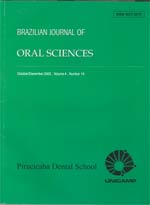
|
Brazilian Journal of Oral Sciences
Piracicaba Dental School - UNICAMP
EISSN:
Vol. 6, No. 21, 2007, pp. 1344-1348
|
 Bioline Code: os07018
Bioline Code: os07018
Full paper language: English
Document type: Research Article
Document available free of charge
|
|
|
Brazilian Journal of Oral Sciences, Vol. 6, No. 21, 2007, pp. 1344-1348
| en |
A new method for extraction of mandibular first molars in rats
Zecchin, Karina Gottardello; Jorge, Rogério da Silva & Jorge, Jacks
Abstract
The aim of the present study is to describe a new technique for the
mandibular first molar extraction based on tooth section in rats. One
hundred and forty Wistar rats, from three different researches
underwent general anaesthesia. Each animal was then positioned on a
specific board and hollemback 3ss was used to make the
syndesmotomy. The mandibular first molars were extracted after tooth
section with carbide 1/4 drills in a high-speed hand piece under constant
irrigation with sterile saline solution. The mesial portion of the first
molar was removed with a modified curved mosquito forceps. The
distal portion was removed and the socket was closed with 5-0 nylon
thread sutures using non-traumatic needles. During the first week
after tooth extraction, animals were fed with regular pressed food to
avoid post-operatory trauma. This technique is careful and avoid
unnecessary trauma, with minimal numbers of fractures (9.3%) and
accidents such as haemorrhage (2%). All the reminiscent roots could
be removed by the described method. Our technique proved to be an
efficient model for future researches on alveolar wound healing with
minimal fractures and accidents and provided better post-extraction
outcomes for the rats.
Keywords
tooth extraction, mandibular molar, wound healing, rats
|
| |
© Copyright 2007 - Piracicaba Dental School - UNICAMP São Paulo - Brazil
Alternative site location: http://www.fop.unicamp.br/brjorals
|
|
